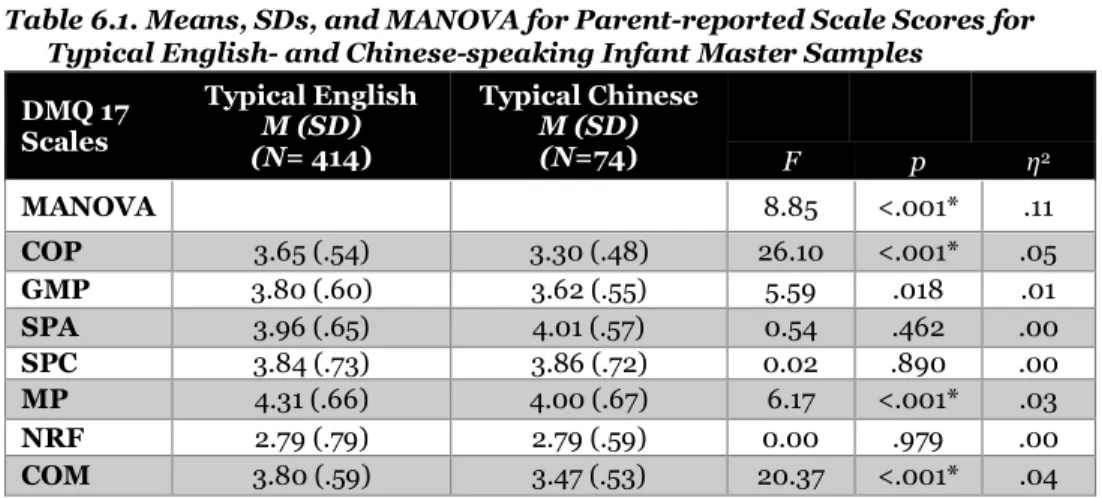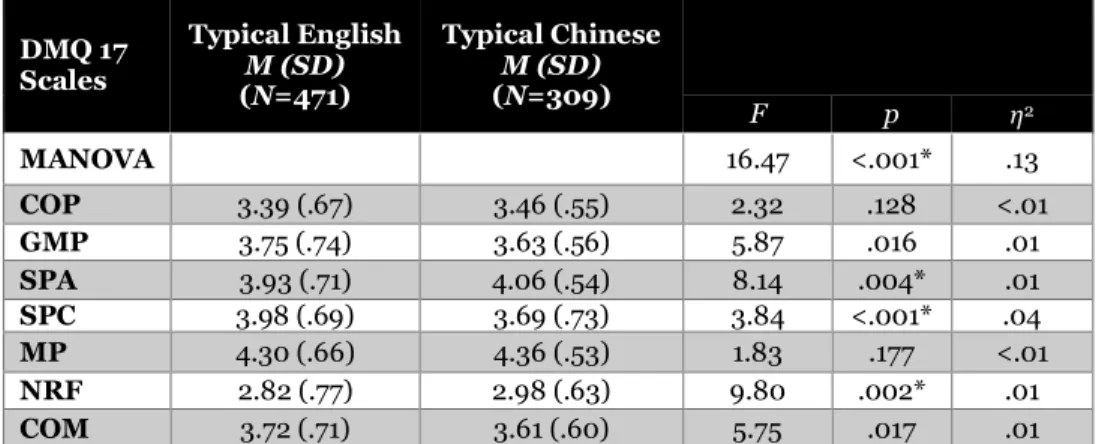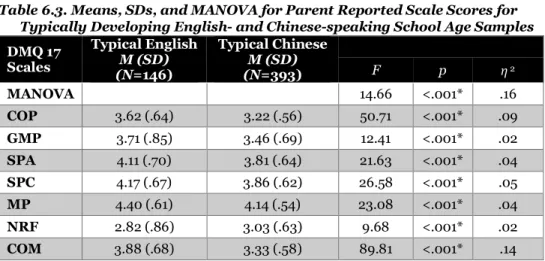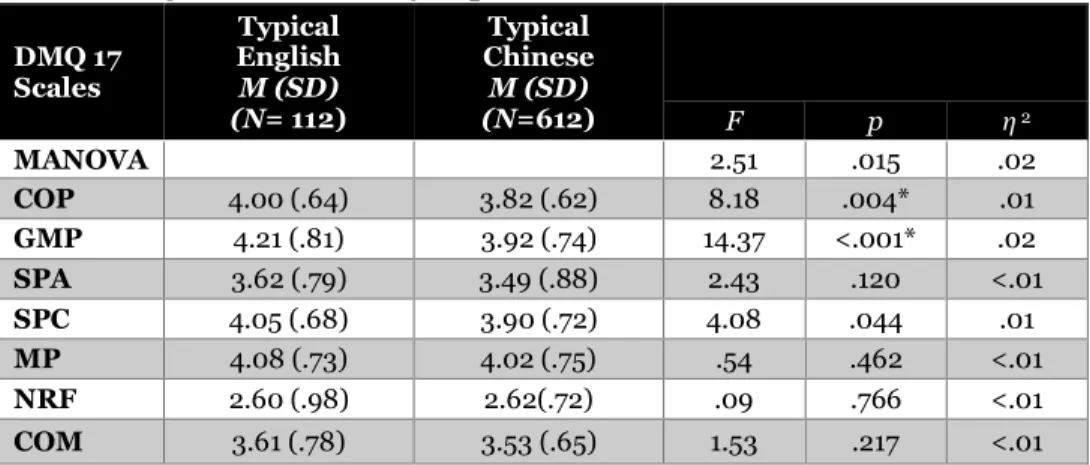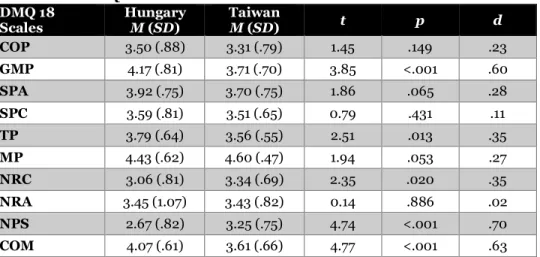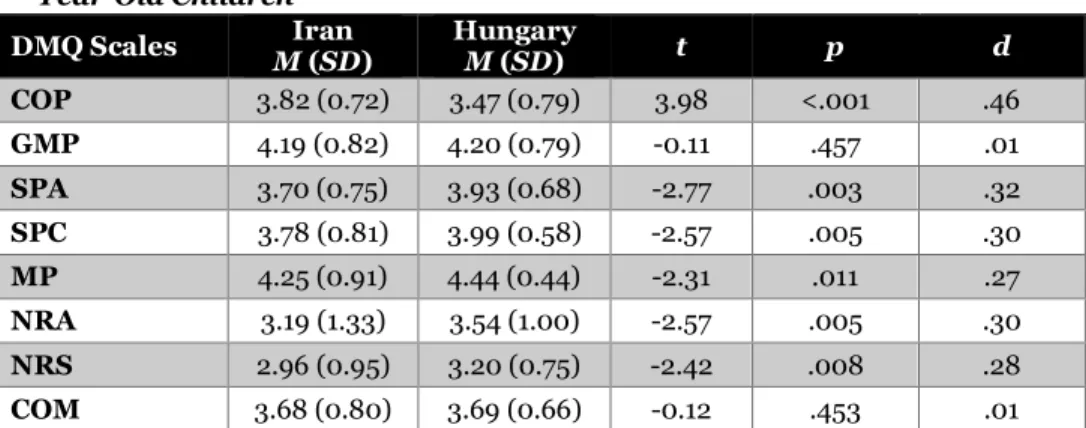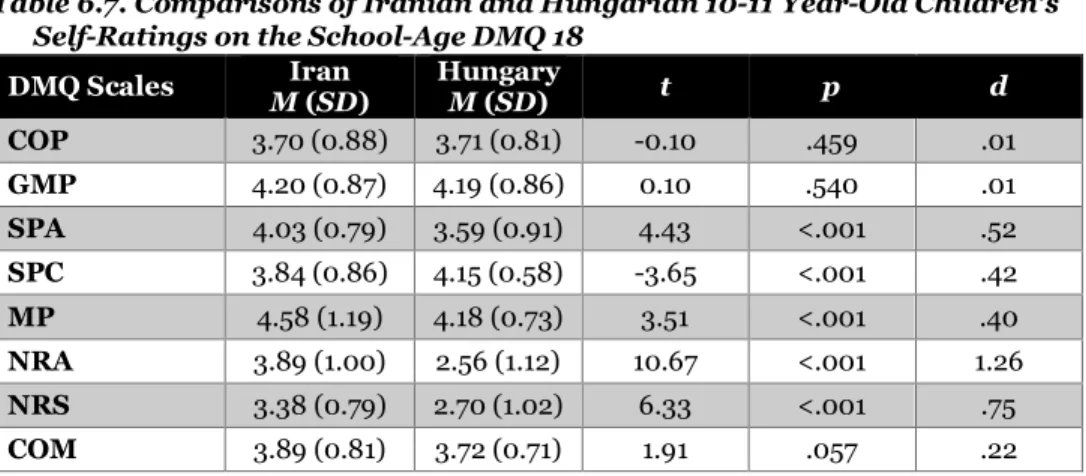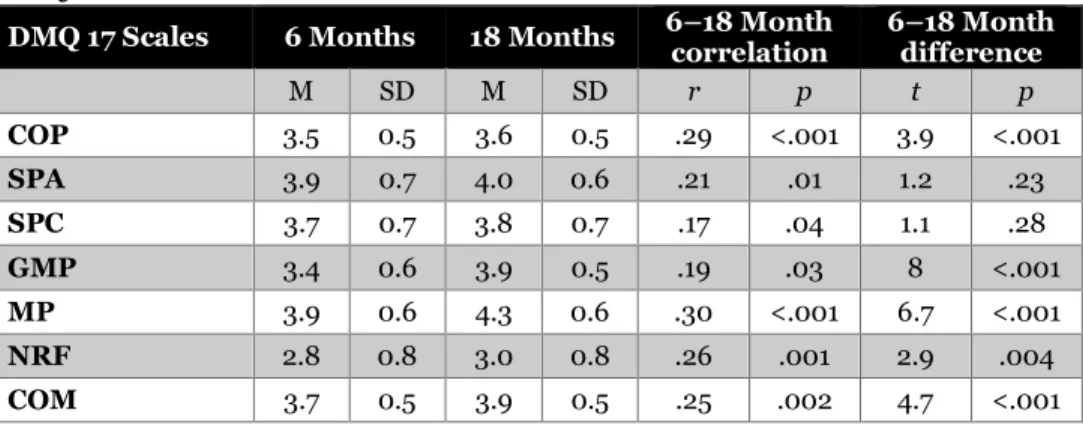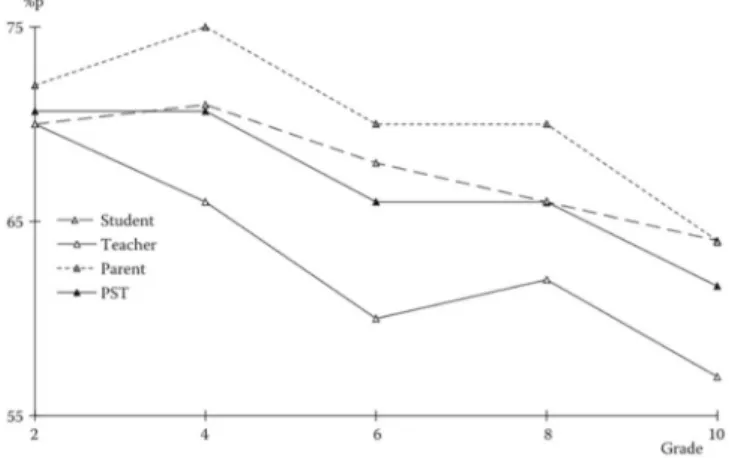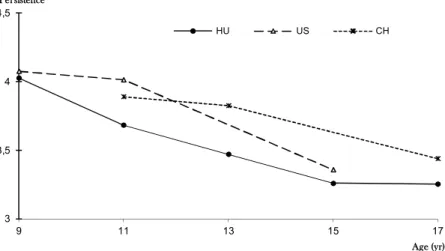Chapter 6
Implications of the DMQ for Education and Human Development: Culture, Age and
School Performance
Krisztián Józsa, Karen Caplovitz Barrett, Stephen Amukune, Marcela Calchei, Masoud Gharib, Shazia Iqbal Hashmi, Judit Podráczky, Ágnes Nyitrai and
Jun Wang
Introduction
There is increased awareness of the importance of both culturally appropri- ate and developmentally appropriate educational practice (e.g., Garcia et al., 2016; Zhao & Fischer, 2013). The child’s cultural background and develop- mental age impact who they are, how they perceive the world and them- selves, and how they relate to others. Mastery motivation, the contexts in which it is observed, and its manifestation in expressive and motor behavior is likely to vary across age, culture, and setting (e.g., home versus school).
For example, there is extensive evidence that mastery motivation decreases with age during the school years (e.g., Józsa et al., 2014). However, this may differ across different cultures and school systems. For example, a common reason given for this downward trajectory is children’s increasing depend- ence on extrinsic motivation from grades and teacher feedback as they get
older. Given that virtually all school systems grade students, this is likely to be true across a variety of cultures. However, more interdependent/collec- tivistic cultures may place more importance on caring about other’s evalua- tions and/or how one’s behavior reflects on one’s roles and obligations to- ward others, in comparison to more independent/individualistic cultures.
As a result, one might expect this extrinsic motivation to be less likely to undermine mastery motivation in more interdependent cultures because children see fulfilling obligations to others as part of who they are. On the other hand, children from cultures that value harmony with others more, self-control more, and individual expression less might be expected to dis- play negative emotions less than those with the reverse pattern. All of these potential differences could impact mastery motivation and, especially, measurement of it using adult reports of children’s mastery motivation.
Moreover, the implications of mastery motivation for education may dif- fer across developmental and cultural contexts. To the extent that home cul- ture and school culture differ, such differences can impact not only the measurement of mastery motivation but the child’s learning, development, and school success. Further, the impact of these differences may change with development.
The DMQ has been used most extensively with English-, Hungarian-, and Chinese-speaking children and their parents and teachers, and it has been translated into many other languages as well. Many important steps were taken to try to ensure comparability of the DMQ in these different lan- guages, as well as appropriateness of the items for all cultures being studied (see Chapter 9). However, it is still important to ascertain whether there are mean-level cultural and/or developmental differences in mastery moti- vation; there may be different educational implications of the DMQ in dif- ferent languages and cultures and for different age groups. This chapter will therefore focus on similarities and differences in mastery motivation, as measured by the DMQ, across culture, language, and age, and it will also describe the utility of the DMQ in predicting school readiness and success in the cultures in which this has been studied.
Defining Culture and Culturally Appropriate Practice
Before discussing this research, however, it is important to define culture and culturally appropriate education. Culture involves values, goals, tradi- tions, expected behavior, shared activities and understandings, and over- arching ways of being that are learned both through active instruction and lived experiences (e.g., Garcia, 1990; Sampson, 2012). Cultures involve lan-
guages, rituals, and artifacts, but they also involve world views, views of hu- man nature, and implicit understandings that are not consciously acknowl- edged or communicated (e.g., Garcia, 1990). In many cases, including in re- search that will be presented in this chapter, country and/or language is used as a proxy for culture; however, even though language is an important part of cultures, multiple cultures use the same language and there are often multiple languages and cultures in the same country. Thus, cross-national comparisons or cross-language comparisons are imperfect indicators of cul- tural differences and similarities. It is also crucial not to over-interpret or overgeneralize any cultural differences that are observed and to avoid stere- otyping cultures based on such differences. As educators, it is imperative to be open to not only differences based in culture but to differences within broad cultural groups and to similarities across different cultures. As well, it is important to recognize that differences or similarities across cultures are often impacted by culture-based perceptions, interpretations, and even use of Likert scales. In order to engage in culturally appropriate education, it is important to keep all of these things in mind, being mindful of the pos- sibility of cultural differences while not assuming that such average differ- ences apply to a particular child and their family.
“Culturally appropriate education” thus, is education that is effectively adapted to cultures and the global context. It involves mindful and culturally sensitive instruction and practice that incorporates and teaches respect for different world views, epistemologies, and cultural traditions, and actively takes into account the diversity of learners and teachers from different cul- tural contexts (Meriam et al., 1928; Rose et al., 2013).
Cultural and Age Comparisons
Research on mastery motivation over the last decade includes research in many different countries, and a number of cross-national studies. The main objectives of many of these studies were to validate the DMQ and/or other measures of mastery motivation in various languages and to investigate pos- sible cultural differences related to this construct. This chapter reviews cross-cultural studies of mastery motivation, studies of mastery motivation in various countries and comparisons of those findings, age-related differ- ences in mastery motivation whenever available, and suggest some direc- tions for future research.
Cultural and Cross-Cultural Studies
In cross-cultural psychological studies, culture is often operationalized as a quasi-independent variable (Berry et al., 2011). This approach is referred to as the etic approach, which examines behavior from a “position outside the
system” and compares cultures (Berry, 1978). The emic approach, in which behaviors are studied using an insider perspective, is an important approach as well that has historically been typical of anthropological studies (Boehnke et al., 2014). This approach focuses on the behaviors, motivation, and values of members of a particular culture, focusing on understanding that culture rather than comparing different cultures. The research presented in this chapter takes an etic approach; however, the development of the DMQ in the different languages represented in this research always involved at least one member of the culture in question, discussions of any perceived cultur- ally inappropriate contexts or constructs, and modifications of both the wording in the new language and, when appropriate, the wording and/or contexts in both languages. An emic approach therefore also was used in the development of the DMQ in new languages.
Mastery motivation is likely to be impacted by a range of contextual fac- tors. Social and cultural groups may have particular expectations about the levels of effort and achievement that are required, and these expectations may differ for subcultures defined by other characteristics, such as gender or socioeconomic status (Blackhurst & Auger, 2008). Economic and politi- cal factors affect educational and career opportunities, which in turn influ- ence individual strivings for mastery.
Cross-cultural studies also are important as a way of testing the general- izability of DMQ, as a measure of mastery motivation, across contexts dif- ferent from its original one, as well as generalizability of mastery motivation theory (Klassen & Usher, 2010; Marsh & Hau, 2004). Not only does this type of study explore the applicability of the theory in different contexts; it can potentially identify new aspects of the theory (Segall et al., 1998; Sue, 1999).
Hence, cross-cultural studies of mastery motivation extend the understand- ing of how it operates, and the extent to which it is valid and generalizable across a variety of cultural contexts. This lays the foundation for studying how mastery motivation is shaped by cultural practices and beliefs and how researchers can explain, rather than simply demonstrating, any observed cross-cultural variations.
Culture and Mastery Motivation
Spiro (1961) was one of the first researchers who described processes through which cultural socialization impacts the motivation of members of that culture. In Spiro’s perspective, one is motivated, through both extrinsic rewards and positive sanctions, to follow cultural teachings; in addition, cul- tures may socialize motivation indirectly, via culturally prescribed goals and norms, which are experienced as intrinsic to the individual. Ryan and Deci (2009) further elaborated that individuals internalize values and behaviors that are viewed positively by their culture, even if they are not initially in-
values and behaviors influence learning and development and also are a source of cultural differences in motivation (Chiu & Hong, 2007; Gelfand &
Triandis, 1998). To the extent that cultures teach the importance of mastery and achievement in particular domains, one would expect children to show greater mastery motivation in that culture in those domains. Importantly, cultural similarities and differences may be evident in ethnic differences within one country (e.g., Wang et al., 2020), in differences between coun- tries with the same language but at least somewhat different cultures, and in broader differences between countries that differ in both language and other important aspects of culture (e.g., Hwang et al., 2017; Józsa et al., 2017).
One of the first cross-cultural studies of mastery motivation was con- ducted by Morgan et al. (2013). This study included more than 13,000 chil- dren from 6 months to 19 years of age, divided into two major samples (a) English speakers from the United States, Canada, the United Kingdom, and Australia; and (b) Chinese speakers from mainland China and Taiwan.
Some of the results presented in this study were based on cross-regional analysis and some on cross-linguistic analysis, enabling some distinction between language and culture. However, since languages are based in a par- ticular culture and express differences that were important to the parent culture, the shared language of the subsamples also indicate at least some shared culture, and cultures that share a language are expected to share more values than cultures differing in both language and country (Kramsch, 2011). Alpha was set at .005 because of the large number of comparisons being made.
Morgan et al. (2013) reported that, in general, English-speaking parents rated their children higher than the Chinese-speaking parents on the DMQ 17 scale scores except for on Negative Reactions to Failure. Moreover, the English- and Chinese-speaking samples were also compared for each age group (infant, preschool, and school-aged children) separately. Although the MANOVAs were significant for each age level, the effect sizes were larger for the univariate comparisons of parent ratings of English- versus Chinese- speaking school-age children than for ratings of infants and preschoolers;
at these younger ages, some of the univariate differences were not signifi- cant. Thus, it appears that the English- versus Chinese-language differences in parent ratings become more pronounced in school-aged children. The comparisons of English- and Chinese-speaking infants for the parent rat- ings of infants (Table 6.1) revealed that English speaking infants were rated higher on three scales: Cognitive/Object Persistence, Mastery Pleasure, and General Competence. For even these three significant differences, the effect sizes were small to medium (Morgan et al., 2013).
Table 6.1. Means, SDs, and MANOVA for Parent-reported Scale Scores for Typical English- and Chinese-speaking Infant Master Samples
DMQ 17 Scales
Typical English M (SD) (N= 414)
Typical Chinese M (SD)
(N=74) F p η2
MANOVA 8.85 <.001* .11
COP 3.65 (.54) 3.30 (.48) 26.10 <.001* .05
GMP 3.80 (.60) 3.62 (.55) 5.59 .018 .01
SPA 3.96 (.65) 4.01 (.57) 0.54 .462 .00
SPC 3.84 (.73) 3.86 (.72) 0.02 .890 .00
MP 4.31 (.66) 4.00 (.67) 6.17 <.001* .03
NRF 2.79 (.79) 2.79 (.59) 0.00 .979 .00
COM 3.80 (.59) 3.47 (.53) 20.37 <.001* .04
Note. Morgan et al., 2013, p.319. COP = Cognitive/Object Persistence, GMP = Gross Motor Persistence, SPA = Social Persistence with Adults, SPC = Social Persistence with Children, MP = Mastery Pleasure, NRF = Negative Reactions to Failure, COM = General Compe- tence.
*Considered to be a statistically significant difference.
Parent ratings of English- and Chinese-speaking preschool children pro- vided more mixed results than either the infant or school-age data. Chinese- speaking preschool children were rated higher by parents than their Eng- lish-speaking peers on Social Mastery Motivation with Adults and on Nega- tive Reactions to Failure, with the effect sizes being small (see Table 6.2).
On the other hand, the English-speaking parents of typically developing pre- schoolers rated their children higher on Social Persistence with Children.
Differences between languages were not significant for the other scales for typically developing preschoolers.
Table 6.2. Means, SDs, and MANOVA for Parent Reported Scale Scores for Typically Developing English- and Chinese-Speaking Preschool Master Samples
DMQ 17 Scales
Typical English M (SD) (N=471)
Typical Chinese M (SD) (N=309)
F p η2
MANOVA 16.47 <.001* .13
COP 3.39 (.67) 3.46 (.55) 2.32 .128 <.01
GMP 3.75 (.74) 3.63 (.56) 5.87 .016 .01
SPA 3.93 (.71) 4.06 (.54) 8.14 .004* .01
SPC 3.98 (.69) 3.69 (.73) 3.84 <.001* .04
MP 4.30 (.66) 4.36 (.53) 1.83 .177 <.01
NRF 2.82 (.77) 2.98 (.63) 9.80 .002* .01
COM 3.72 (.71) 3.61 (.60) 5.75 .017 .01
Note. Morgan et al., 2013, p.320. COP = Object-oriented Persistence, GMP = Gross Motor Persistence, SPA = Social Persistence with Adults, SPC = Social Persistence with Children, MP = Mastery Pleasure, NRF = Negative Reactions to Failure, COM = General Compe- tence.
*Considered to be a statistically significant difference.
The results of cross-cultural comparisons of English- and Chinese-speak- ing parent ratings of elementary school-aged children, presented in Table 6.3, indicate that English-speaking parents rated their children higher on all four instrumental mastery motivation scales, along with Mastery Pleasure and General Competence. The Chinese parents rated their children higher on Negative Reactions to Failure. However, the effect sizes varied from small for Negative Reactions and Gross Motor Persistence to large for Gen- eral Competence. The authors concluded that it was hard to determine whether these are true cultural motivational and behavioral differences or whether the Chinese parents of school-aged children had higher expecta- tions for mastery motivation and for control of negative emotions and/or were less influenced by social desirability than the English-speaking par- ents. It seems less likely that parents from different language backgrounds were simply using the rating scale differently and/or there were differences due to translation difficulties, if one takes into consideration the data from Table 6.2 that shows that the Chinese parents of preschoolers rated their children higher on some scales, even though rating scales and translations were the same. However, as just noted and shown in Table 6.3, the parents of Chinese school-aged children rated them lower than the English-speak- ing parents on all scales except Negative Reactions to Failure.
Table 6.3. Means, SDs, and MANOVA for Parent Reported Scale Scores for Typically Developing English- and Chinese-speaking School Age Samples DMQ 17
Scales
Typical English M (SD) (N=146)
Typical Chinese M (SD)
(N=393) F p η 2
MANOVA 14.66 <.001* .16
COP 3.62 (.64) 3.22 (.56) 50.71 <.001* .09
GMP 3.71 (.85) 3.46 (.69) 12.41 <.001* .02
SPA 4.11 (.70) 3.81 (.64) 21.63 <.001* .04
SPC 4.17 (.67) 3.86 (.62) 26.58 <.001* .05
MP 4.40 (.61) 4.14 (.54) 23.08 <.001* .04
NRF 2.82 (.86) 3.03 (.63) 9.68 <.001* .02
COM 3.88 (.68) 3.33 (.58) 89.81 <.001* .14
Note. Morgan et al., 2013, p.320. COP = Object-oriented Persistence, GMP = Gross Motor Persistence, SPA = Social Persistence with Adults, SPC = Social Persistence with Children, MP = Mastery Pleasure, NRF = Negative Reactions to Failure, COM = General Compe- tence.
*Considered to be a statistically significant difference.
In contrast to their parents, Chinese elementary school-aged children did not rate themselves differently from English-speaking children on DMQ Mastery Pleasure and Negative Reactions to Failure, as shown in Table 6.4.
Moreover, the overall MANOVA was not statistically significant with alpha set at .005 (p = .015) and the effect size was small. The English-speaking children rated themselves higher than the Chinese-speaking children only on Cognitive/Object Persistence and Gross Motor Persistence, and the effect sizes of these differences were small. Thus, while most of the English versus Chinese language comparisons were in the same direction for the parent and for child self-ratings of school-aged children, the effect sizes of most differ- ences were much smaller for the child self-ratings. However, in the case of Gross Motor Persistence, the child self-rating difference and effect size was very similar to those of parents, with English-speaking children rated higher than the Chinese by both their parents and themselves. It appears that Eng- lish-language school-aged children are more motivated to master physical and athletic skills than their Chinese peers. Finally, both Chinese- and Eng- lish-speaking children rated Gross Motor Persistence, Mastery Pleasure, and Social Mastery with Children higher than they rated Social Mastery with Adults, General Competence, and Negative Reactions to Failure.
This order of importance of motives is similar to what Józsa (2007) found in his large Hungarian sample. However, Józsa et al. (2014) compared DMQ 17 self-ratings of 11-year-old children from Hungary and China and found that the Chinese children rated themselves higher on General Competence rather than Cognitive/Object Persistence. The lower ratings of Chinese chil-
dren on Gross Motor Persistence were identified by both studies. More re- search is needed to ascertain whether these differences are also observable in behavior; nevertheless, studies with the DMQ consistently support lower Gross Motor Persistence in Chinese-speaking children relative to children speaking English and Hungarian.
Table 6.4. Means, SDs, and MANOVA for English and Chinese Elementary School-Aged Children’s Self-Reports
DMQ 17 Scales
Typical English M (SD) (N= 112)
Typical Chinese M (SD)
(N=612) F p η 2
MANOVA 2.51 .015 .02
COP 4.00 (.64) 3.82 (.62) 8.18 .004* .01
GMP 4.21 (.81) 3.92 (.74) 14.37 <.001* .02
SPA 3.62 (.79) 3.49 (.88) 2.43 .120 <.01
SPC 4.05 (.68) 3.90 (.72) 4.08 .044 .01
MP 4.08 (.73) 4.02 (.75) .54 .462 <.01
NRF 2.60 (.98) 2.62(.72) .09 .766 <.01
COM 3.61 (.78) 3.53 (.65) 1.53 .217 <.01
Note. Morgan et al., 2013, p.322. COP = Object-oriented Persistence, GMP = Gross Motor Persistence, SPA = Social Persistence with Adults, SPC = Social Persistence with Children, MP = Mastery Pleasure, NRF = Negative Reactions to Failure, COM = General Compe- tence.
*Considered to be a statistically significant difference.
Morgan et al. (2013) also compared preschool children in Taiwan (Tai- pei) and mainland China (Hangzhou). This within-language, cross-cultural comparison indicated that mainland Chinese parents rated their preschool- ers lower than Taiwanese parents on Mastery Pleasure and especially Gen- eral Competence. Although these two countries share Confucian/Taoist his- torical cultural roots, the current political, educational, and social systems differ. One possible explanation of these differences in mastery motivation is that China’s one-child policy and continued norm of one-child families led to higher parental expectations for their only children’s achievement and connectedness with the parents, so they see them as lower relative to these higher expectations. More research is needed to replicate these findings and to explore whether different parental expectations and/or parenting behav- iors might contribute to differences in mastery motivation in these different Chinese cultures and how much is attributable to expectation and interpre- tation versus actual differences in behavior.
Morgan et al. (2017) studied cross-national cultural differences between Hungarian and Taiwanese parents’ ratings of their preschool children on the DMQ 18 (Table 6.5). They found that Hungarian parents’ ratings of their preschool children were higher than those of Taiwanese parents on Gross
Motor Persistence and General Competence. In contrast, parents in Taiwan rated their children higher on Negative Reactions to Challenge-Sad- ness/Shame than parents in Hungary (Morgan et al., 2017). Note that alt- hough fewer differences were significant than found for DMQ 17 compari- sons of English and Chinese-speaking children; the effect sizes for most comparisons in the DMQ 18 study were much larger and the sample size was much smaller, suggesting differences in power between the two studies may have impacted results. Importantly, the difference in findings for the two subscales of the Negative Reactions to Challenge support the need for this distinction and the advisability of further work to refine these subscales.
Table 6.5. Comparisons of Parent Ratings of Typically Developing 1-5 Year- Old Children from Hungary (n = 152) and Taiwan (n = 61) on the
Preschool DMQ 18
Note. Morgan et al., 2017, p.59. COP = Cognitive/Object Persistence, GMP = Gross Motor Persistence, SPA = Social Persistence with Adults, SPC = Social Persistence with Children, TP = Total Persistence, MP = Mastery Pleasure, NRC = Negative Reactions to Challenge, NRA = Negative Reactions Anger/Frustration, NRS = Negatives Reaction Sad-
ness/Shame, COM = General Competence.
Hungarian school-aged children’s mastery motivation, as self-reported and reported by parents using DMQ 18, also has been compared to those same reports on Iranian children. Tables 6.6 and 6.7 summarize the results of that study (Józsa & Gharib, 2019). As the tables suggest, there were re- ported differences between Hungarian and Iranian children in social and affective aspects of mastery motivation regardless of the rater; however, in- terestingly, the direction of these differences often depended on the rater.
Whereas Hungarian parents reported higher levels of Social Persistence with Adults, Social Persistence with Children, Mastery Pleasure, Negative Reactions to Challenge/shame/sadness, and Negative Reactions to Chal-
DMQ 18 Scales
Hungary M (SD)
Taiwan
M (SD) t p d
COP 3.50 (.88) 3.31 (.79) 1.45 .149 .23
GMP 4.17 (.81) 3.71 (.70) 3.85 <.001 .60
SPA 3.92 (.75) 3.70 (.75) 1.86 .065 .28
SPC 3.59 (.81) 3.51 (.65) 0.79 .431 .11
TP 3.79 (.64) 3.56 (.55) 2.51 .013 .35
MP 4.43 (.62) 4.60 (.47) 1.94 .053 .27
NRC 3.06 (.81) 3.34 (.69) 2.35 .020 .35
NRA 3.45 (1.07) 3.43 (.82) 0.14 .886 .02
NPS 2.67 (.82) 3.25 (.75) 4.74 <.001 .70
COM 4.07 (.61) 3.61 (.66) 4.77 <.001 .63
lenge/anger/frustration than Iranian parents, Hungarian children self-re- ported lower levels of all of these scales except for Social Persistence with Children, in comparison with Iranian children. Children’s self-reported So- cial Persistence with Children showed the same pattern found for parental reports, with Hungarian children reporting higher Social Persistence with Children compared to Iranian children (see Table 6.7).
Table 6.6. Comparisons of Parent Ratings on the School-Age DMQ 18 of Typically Developing Iranian (n = 114) and Hungarian (n = 140) 10-11 Year-Old Children
Note. Józsa & Gharib (2019). Abbreviation: COM = General Competence; COP = Cogni- tive/Object Persistence; GMP = Gross Motor Persistence; MP = Mastery Pleasure, NRA = Negative Reactions Anger/Frustration, NRS = Negatives Reaction Sadness/Shame; SPA
= Social Persistence with Adults; SPC = Social Persistence with Children.
Iranian parents also reported higher Cognitive/Object Persistence for their children compared to Hungarian parents’ reports. No significant cul- tural differences were found for Gross Motor Persistence or General Com- petence, according to parent or child report, and children’s self-reported Cognitive/Object Persistence was comparable for Iranian and Hungarian children. These different findings for cultural differences in parentally re- ported versus self- reported mastery motivation may have been due, at least in part, to notable differences between mastery motivation as reported by Iranian children and their parents. Iranian parents reported significantly lower levels of Social Persistence with Adults, Mastery Pleasure, Negative Reactions to Challenge- Shame/sadness and Negative Reactions to Chal- lenge-Anger/frustration compared to their children. In addition, surpris- ingly, the internal consistency reliability was lower for Iranian parents rel- ative to their children, in many cases being unacceptably low (see Gharib et al., 2021). This pattern is contrary to the general trend for self-reports to be less reliable than parent-reports (see Chapter 5). These reliability findings suggest the need for caution in interpreting the parent report cultural dif- ferences and the need for further research on mastery motivation in Iranian children.
DMQ Scales Iran M (SD)
Hungary
M (SD) t p d
COP 3.82 (0.72) 3.47 (0.79) 3.98 <.001 .46
GMP 4.19 (0.82) 4.20 (0.79) -0.11 .457 .01
SPA 3.70 (0.75) 3.93 (0.68) -2.77 .003 .32
SPC 3.78 (0.81) 3.99 (0.58) -2.57 .005 .30
MP 4.25 (0.91) 4.44 (0.44) -2.31 .011 .27
NRA 3.19 (1.33) 3.54 (1.00) -2.57 .005 .30
NRS 2.96 (0.95) 3.20 (0.75) -2.42 .008 .28
COM 3.68 (0.80) 3.69 (0.66) -0.12 .453 .01
In conclusion, cross-sectional cross-cultural studies of mastery motiva- tion have identified some differences between languages, countries speak- ing the same language, and age groups on the DMQ scales, but also many similarities across cultures and ages. Much more research is needed, to ex- amine socialization processes that help explain observed differences and to see if the same findings are obtained using behavioral measures. In addi- tion, it is important to examine actual developmental change and stability in mastery motivation, using longitudinal designs. We will now review such studies.
Table 6.7. Comparisons of Iranian and Hungarian 10-11 Year-Old Children’s Self-Ratings on the School-Age DMQ 18
Note. Józsa & Gharib (2019).
Abbreviation: COP = Cognitive/Object Persistence, GMP = Gross Motor Persistence, SPA
= Social Persistence with Adults, SPC = Social Persistence with Children, MP = Mastery Pleasure, NRA = Negative Reactions Anger/Frustration, NRS = Negatives Reaction Sad- ness/Shame, COM = General Competence.
Backman et al., (2006) reported longitudinal data for a large community sample of U.S. infants whose parents rated them on the DMQ 17 at 6, 12, and 18 months. This study found a significant increase in the ratings of the motivation of these infants from 6 to 12 months on Cognitive/Object and Gross Motor Persistence and Mastery Pleasure. Similarly, Sparks et al.
(2012) collected parent-report DMQ 17 data on these U.S. infants when the children were 6-, 12-, 18- and 42-months old. The researchers found that mastery motivation improved from 6 to 18 months of age for all subscales except the two social persistence scales, which showed no significant change over time (see Table 6.8).
DMQ Scales Iran M (SD)
Hungary
M (SD) t p d
COP 3.70 (0.88) 3.71 (0.81) -0.10 .459 .01
GMP 4.20 (0.87) 4.19 (0.86) 0.10 .540 .01
SPA 4.03 (0.79) 3.59 (0.91) 4.43 <.001 .52
SPC 3.84 (0.86) 4.15 (0.58) -3.65 <.001 .42
MP 4.58 (1.19) 4.18 (0.73) 3.51 <.001 .40
NRA 3.89 (1.00) 2.56 (1.12) 10.67 <.001 1.26
NRS 3.38 (0.79) 2.70 (1.02) 6.33 <.001 .75
COM 3.89 (0.81) 3.72 (0.71) 1.91 .057 .22
Table 6.8. Age Comparisons of DMQ 17 Between 6-Month and 18-Month Old Infants
DMQ 17 Scales 6 Months 18 Months 6–18 Month correlation
6–18 Month difference
M SD M SD r p t p
COP 3.5 0.5 3.6 0.5 .29 <.001 3.9 <.001
SPA 3.9 0.7 4.0 0.6 .21 .01 1.2 .23 SPC 3.7 0.7 3.8 0.7 .17 .04 1.1 .28
GMP 3.4 0.6 3.9 0.5 .19 .03 8 <.001
MP 3.9 0.6 4.3 0.6 .30 <.001 6.7 <.001
NRF 2.8 0.8 3.0 0.8 .26 .001 2.9 .004
COM 3.7 0.5 3.9 0.5 .25 .002 4.7 <.001
Note. Sparks et al. (2012).
Abbreviation: COM = General Competence; COP = Object-oriented Persistence; GMP = Gross Motor Persistence; MP = Mastery Pleasure; NRF = Negative Reactions to Failure;
SPA = Social Persistence with Adults; SPC = Social Persistence with Children.
Ross and Hunter (2010) also followed 29 of the participants until the age of 3.5 years. Interestingly, from age 18 months until 3.5 years, these children showed increases in social persistence with adults, as well as mastery pleas- ure and general competence (Table 6.9). Thus, this 36-month longitudinal study highlighted that different aspects of mastery motivation show stability and change at different ages during infancy and toddlerhood in U.S. infants.
More research is needed to see if similar age trends are found in other coun- tries.
This longitudinal study beginning in infancy was valuable in showing ac- tual developmental change, but it was limited to U.S. children. Research ex- amining longitudinal change in mastery motivation in other countries has been conducted with older aged children. In 2013, Józsa and Molnár studied mastery motivation in school-aged children in Hungary and concluded that mastery motivation underwent a considerable decline from fourth grade to tenth grade (see Figure 6.1). This was similar to earlier research findings with U.S. children using measures of intrinsic motivation, a related con- struct (e.g., see Gottfried et al., 2001; Harter, 1992). Similar declines in mo- tivation for older elementary school children (age 11) compared to ratings by younger elementary school children (age 9) were reported by Morgan et al. (2013).
Table 6.9. Age Comparisons of DMQ 17 Between 18-Month and 3.5-Year-Old Children
DMQ 17 Scales
18 monthsa 3.5 yearsb Reliability Diff.
M SD M SD α at
age 3.5 r t
COP 3.71 .57 3.50 .60 .83 .46 1.78
GMP 3.80 .54 3.81 .57 .83 .70 -.15
SPA 3.91 .62 4.19 .70 .87 .60 -2.56*
SPC 3.82 .71 3.99 .77 .91 .40 -1.10
MP 4.11 .66 4.54 .49 .68 .60 -4.31**
NRF 2.87 .82 2.52 .73 .68 -.03 1.67
COM 3.78 .53 4.03 .53 .68 .65 -3.00**
Note. Ross and Hunter (2010).
Abbreviation: COM = General Competence; COP = Cognitive/Object Persistence; GMP = Gross Motor Persistence; MP = Mastery Pleasure; NRF = Negative Reactions to Failure;
SPA = Social Persistence with Adults; SPC = Social Persistence with Children.
*p < .05, **p < .01, ªN = 28, bN=29.
Figure 6.1. Age Differences in Total Mastery Motivation of DMQ 17 Note. Józsa and Molnár (2013, p.278).
Abbreviation: PST = parent, student and teacher combined
Analyzing each scale separately, Józsa and Molnár (2013) concluded that Gross Motor Persistence showed the most significant decline throughout the entire age period, followed by Cognitive/Object Persistence, which con- sistently and significantly decreased after age 10. Social Persistence with Adults showed a more moderate but statistically significant decline from grade 4 to grade 6; whereas Social Persistence with Children and Mastery Pleasure did not significantly decline during the school years; in fact Mas-
were further supported by Józsa et al. (2014), who identified declines in to- tal persistence for Chinese, American, and Hungarian students (Figure 6.2).
In all three cultures, there was a significant decline from age 11 or 13 to later adolescence. Declines were also seen in all three cultures on three of the four persistence measures: Cognitive/Object Persistence, Gross Motor Persis- tence, and Social Persistence with Children. The Chinese and Hungarian children also showed a decline on Social Persistence with Adults.
Figure 6.2. Age Changes in Total Persistence of DMQ 17 for the US, Chinese, and Hungarian Students
Note. Józsa et al. (2014, p.10).
Abbreviation: CH = Chinese; HU = Hungarian; US = American
In contrast with the findings for the persistence scales, the trends for mastery pleasure were less clear and varied across cultures. The Chinese and American samples had no significant age differences, while in the large Hungarian sample, there was a significant decrease in these self-ratings of mastery pleasure from 9 to 13. In all samples, though, the effect size for age effects on mastery pleasure, was small (Józsa et al., 2014).
In addition to declines in mastery motivation, the researchers found de- clines in General Competence that varied by culture. There was not a signif- icant decline in the U.S. competence ratings, as shown in Table 6.10. Alt- hough there was a significant decline in the Hungarian ratings from second grade until fourth grade, afterwards they were mostly flat. There was, how- ever, a significant linear decline in ratings for the Chinese sample, with a small effect size. Thus, there were significant cultural differences in self-per- ceived General Competence at age 16. The Chinese teens rated their compe- tence as lower than both the Hungarian and U.S. teens, and the U.S. teens
3 3,5 4 4,5
9 11 13 15 17
Persistence
Age (yr)
HU US CH
rated themselves as more competent than the Hungarians. This at first might seem surprising given how well Chinese teens perform on academic tests, but it is consistent with other evidence about cultural influences on the self-perceptions of Chinese youth.
Table 6.10. Significant Age Group Comparisons of DMQ 17 Samples
U.S. China Hungary
DMQ Scales (N=200) (N=1582) (N=5791)
Age compared {7-12} v. {13-17} {10-12} v. {13-15} v. {16-19} {10} v. {12} v. {14} v. {16}
COP {7-12} > {13-17} {10-12}, {13-15} > {16-19} {10} > {12,14} > {16}
GMP {7-12} > {13-17} {10-12}, {13-15} > {16-19} {10} > {12} > {14} > {16}
SPA — {10-12} > {13-15} > {16-19} {10} > {12,14,16}
SPC {7-12} > {13-17} {10-12}, {13-15} > {16-19} {10,12} > {14,16}
MP — — —
TMM {7-12} > {13-17} {10-12}, {13-15} > {16-19} {10} > {12} > {14} > {16}
NRF {7-12} < {13-17} {10-12} > {13-15}, {16-19} —
COM — {10-12} > {13-15} > {16-19} —
Abbreviation: COM = General Competence; COP = Cognitive/Object Persistence; GMP = Gross Motor Persistence; MP = Mastery Pleasure; NRF = Negative Reactions to Failure;
SPA = Social Persistence with Adults; SPC = Social Persistence with Children; TMM = To- tal Mastery Motivation.
When comparing total persistence across cultures, the researchers iden- tified similar levels at 11 across cultures but more significant cultural differ- ences at age 16. On total persistence at age 11, the overall difference was not significant at p < .01. In contrast, at age 16, the overall difference was signif- icant; the U.S. and Hungarian teens rated themselves higher than the Chi- nese teens rated themselves on total persistence.
The researchers found little evidence of a significant decline in mastery pleasure with age. The Chinese and American samples had no significant age differences, and although in the extensive Hungarian sample there was a significant decrease in these self-ratings of mastery pleasure from 9 to 13, the effect size for age differences on mastery pleasure was small (Józsa et al., 2014). These findings suggest that the reduced persistence is not likely a
it seems plausible that increased difficulty and time intensiveness of school- work with age contribute to the reduced mastery motivation. There is some evidence that decreased perceived competence is associated with later de- creased motivation, which is consistent with the idea that difficulty level plays a role in decreased motivation (e.g., Harter, 1992). In conclusion, alt- hough there are some cultural differences in age-related declines in General Competence and some aspects of mastery motivation, there are more cross- cultural similarities than differences. Further research is needed to ascer- tain the influences on these age-related changes in the various cultures.
Relationship of Mastery Motivation with School Success
Relationship with Cognitive Skills
Probably the most important reason that these studies of mastery motiva- tion are important to educators is that there is a wealth of evidence that mastery motivation is a strong predictor of cognitive skill development, playing a crucial role in school achievement (Józsa & Molnár, 2013; Yarrow et al., 1975). A child's tendency to persist on cognitive tasks even when they become challenging would seem crucial for success in school and beyond.
This prediction has typically been tested using cross-sectional designs. For example, Józsa (2007) found that Hungarian teachers' ratings of students' Cognitive/Object Persistence correlated with students’ basic skill develop- ment: .79 in grade 3 and .64 in grade 6. Józsa and Molnár (2013) collected a large set of cross-sectional data in grades 2, 4, 6, 8, and 10. Altogether, 365 classes were involved. Self-report questionnaires were administered to 7,410 students. Reports of teachers (about 3,504) and parents (about 3,843) were also collected. The sample was representative of Hungary in terms of gender, geographical distribution, and parents' highest level of education.
Combined (Parent, Student, and Teacher) ratings of Cognitive/Object Persistence were found to be correlated strongly, around 0.80, with grade point average (GPA), and teacher and parent ratings also were strongly cor- related with GPA. However, there was a weaker correlation between stu- dents’ ratings of Cognitive/Object Persistence and GPA. Importantly, in a multiple regression predicting GPA from Cognitive/Object Persistence, Ra- ven IQ scores, and basic skills, all three variables were predictors, but Cog- nitive/Object Persistence more strongly predicted GPA than either IQ or cognitive skills. Hence, it seems that Cognitive/Object Persistence contrib- uted more powerfully to school achievement than cognitive development tests (Józsa & Molnár, 2013).
In addition to cross-sectional studies, longitudinal studies have sup- ported the relation between mastery motivation and school achievement.
Józsa and Morgan (2014) found that persistence at grade 4 significantly pre- dicted grade point average (GPA) in grade 8. Children's persistence at chal- lenging cognitive tasks also has been a significant predictor of school-re- lated skills such as language and math achievement (e.g., Gilmore et al., 2003; Mercader et al., 2017; Mokrova et al., 2013). Gilmore et al. (2003) demonstrated that, for girls only, parentally reported mastery motivation predicted IQ and spelling and reading achievement six years later. They found a significant relationship between maternal ratings of girls’ persis- tence at age 2 on the DMQ and age 8 cognitive ability (r = .61, p < .01) and achievement in reading and spelling (r = .64 & .59, respectively, p < .01).
However, there was no correlation between age two and age eight measures for boys, apart from a negative correlation of maternal ratings at age 2 with age eight boys' self-reported motivation for reading (Gilmore et al., 2003).
Józsa and Barrett (2018) used Structural Equations Modeling to explore the relationship between affective aspects of mastery motivation at pre- school age and math and reading scores at grade 2 in 327 Hungarian chil- dren. Children’s IQ (β = .26, p < .01) and SES (β = .32, p < .01) significantly and positively predicted math achievement, while Negative Reactions to Failure was a significant, negative predictor (β = -.16, p < .05). Mastery Pleasure did not significantly predict math achievement. First grade math performance strongly predicted second-grade math performance (β = .80, p < .01).
A somewhat different pattern emerged in predicting reading. IQ did not significantly predict first-grade reading achievement, while socioeconomic status (SES) (β = .35, p < .01) and Mastery Pleasure (β = .20, p < .01) both had significant, positive coefficients. Negative Reactions to Failure’s coeffi- cient was significant and negative (β = -.19, p < .05), as it was for mathemat- ics. The relation between first- and second grade reading was also strong (β
= .60, p < .01).
Relationship with Social Skills
Less attention has been given to the role of mastery motivation in social and emotional competence, a set of skills that enable children to successfully in- teract with peers and adults (social skills), to recognize and label emotions in self and others, and have empathy and ability to self-regulate emotions and behavior.There is now substantial evidence that children’s social emo- tional competence influences their ability to adjust to the school environ- ment and succeed in both school and in other important life settings. Much as Cognitive/Object Persistence contributes importantly to cognitive skill development, social and affective aspects of mastery motivation are likely to
be important predictors of social skills, which play important roles in suc- cess in school and life. Józsa & Barrett (2018) used Structural Equations Modeling to examine the role of affective aspects of mastery motivation, so- cial mastery motivation, and Socio-Economic Status (SES) in the preschool period in longitudinally predicting social skills in grade 2 in 327 Hungarian children. Affective and social mastery motivation were measured using the Teacher report of the Dimensions of Mastery Questionnaire (DMQ; Morgan, 1997; Morgan et al., 2009) specifically the Social Persistence with Children and Mastery Pleasure scales, along with a new scale measuring negative emotion/withdrawal following failure. Social skills were assessed using DIFER (Diagnostic Assessment Systems for Development, Nagy et al., 2016) in grade 1 and 2, and social skills at grade 1 was used as an additional pre- dictor. Social Persistence with Children (SPC) significantly and positively predicted first-grade social skills (β = .21, p < .01). The coefficient for SES (β = .31, p < .01) was also significant. Negative/withdrawal to failure nega- tively predicted social skills (β = -.23, p < .01), but Mastery Pleasure did not significantly predict social skills in this model. The relationship between first- and second-grade social skills was quite high (β = .88, p < .01).
Subject Specific Mastery Motivation among Different Grades Based on Barrett and Morgan’s (1995) definition, Józsa (2014) described further dimensions of mastery motivation, assuming that mastery motiva- tion had school-specific dimensions, and could vary in different school do- mains, i.e. different subjects. He developed new scales to measure school subject-specific dimensions of mastery motivation. The Subject-Specific Mastery Motivation Questionnaire (SSMMQ, Józsa, 2014) covers six school subjects/domains (reading, mathematics, science, English as a foreign lan- guage, art, and music) and also school mastery pleasure. The questionnaire consists of 5-point Likert items: 6 items in each scale, with 42 items alto- gether in the seven scales. The total score of the six subject-specific scales was considered to be a measure of school mastery motivation. The school mastery pleasure scale includes six items, each of them related to one of the school domains. Academic mastery pleasure and academic mastery motiva- tion were computed scales based only on the reading, math, and science items. Based on suggestions by Józsa and Morgan (2017), the SSMMQ scales included only positive items.
As mentioned earlier, there is a developmental decline in Cognitive / Ob- ject Persistence in middle school-aged children compared to younger school-aged children (Józsa et al., 2014; Józsa & Morgan, 2014). However, it was important to see whether this decline with age characterized only some subjects for subject-specific mastery motivation, and whether the sub- jects that declined differed for different cultural groups.
Józsa et al. (2017) investigated subject-specific mastery motivation of Hungarian (N = 1359) and Taiwanese (N = 623) children from grades 4, 6, 8, and 10. In Hungarian children, mastery motivation decreased from grade 4 to 8 in all subjects except English as a foreign language (see Table 6.11).
There were significant grade level decreases in Hungary in reading (F = 55.95, p < .001), math (F = 70.90, p < .001, and science (F = 47.75, p < .001.
In art (F = 128.53, p < .001) the decline was steep and continued throughout the period studied; whereas, in music (F = 82.90, p < .001) the downward slope grew less steep beginning in grade 8. In contrast, there was less decline in English (F = 4.46, p < .05), which only dropped a little from grade 4 to grade 6, and remained constant after that.
Although there were significant grade level differences in Taiwan (see Ta- ble 6.11), the decline was not a linear decline throughout the period. There were significant age differences in reading (F = 7.43, p < 0.001), math (F = 14.38, p < 0.001), science (F = 7.63, p < .001), English (F = 4.17, p < .05), art (F = 19.10, p < .001), but not in music (F = 1.07, p = .344). For reading, math, and science, the youngest and oldest children reported the highest motivation, so the pattern was quite different from that found in Hungary.
Similar to Hungary, the motive to master English as a foreign language stayed essentially constant from grades 6 to 10, but it was somewhat higher at grade 4. In summary, in Taiwan, there was a significant decline in subject- specific mastery motivation following elementary school, but motivation to master reading, math, and science returned again to its higher level in 10th grade. Moreover, motivation to learn English as a second language did not decline as much, remaining high throughout the period studied.
Table 6.11. Significant Age Group (School Grade) Comparisons of the Subject Specific Mastery Motivation Scales
SSMMQ Scales Hungary
(N = 1359)
Taiwan (N = 623) Reading {4} > {6} > {8, 10} {4, 10} > {6, 8}
Math {4} > {6} > {8, 10} {4, 10} > {6, 8}
Science {4} > {6} > {8, 10} {4, 10} > {6, 8}
English {4} > {6, 8, 10} {4} > {6, 8, 10}
Art {4} > {6} > {8 > {10} {4} > {6} > {8}
Music {4} > {6} > {8} > {10} {4} > {6, 8}
Note. Józsa et al. (2017). Abbreviations: SSMMQ = Subject-Specific Mastery Motivation Questionnaire.
Conclusion
The present body of research on cultural influences on mastery motivation highlights the need to expand the scope of research to cultures that have not yet been studied, to study socialization and other cultural processes that could be mechanisms for any cultural differences, and to study behavioral measures of mastery motivation in addition to using the DMQ. These stud- ies will be important in extending our understanding of mastery motivation and better enabling culturally appropriate educational practice. Future re- search on mastery motivation should also include a variety of age groups, measures, and analyses in the same study, to enable better understanding of the roles of both development and culture in mastery motivation. In ad- dition to cross-national studies, the comparison of ethnic groups within a country and regional similarities and differences in mastery motivation is needed. In such studies, it will be important to decide which comparisons to make based on conceptually important and observed cultural similarities and differences in relevant characteristics, such as socialization processes, cultural ideologies, and school systems. These studies should address the social, political, and economic ecologies that are likely to have an impact both on culture and motivation.
Another important direction for such research is to carefully study how the cultures are changing over time. Some countries, such as China, are un- dergoing rapid sociopolitical and economic change, which is likely to impact cross-temporal comparisons of mastery motivation. It is particularly im- portant to replicate older studies, to see if observed cross-cultural differ- ences are still observed. Moreover, it will be important to explore the impact not only of ongoing sociopolitical and economic change, but also more rapid change due to major world crises, such as the current pandemic and eco- nomic crisis, on mastery motivation. For instance, it will be important to explore whether the need for online and hybrid delivery of education was associated with changes in mastery motivation in school-aged children and university students.
Finally, there is a need to take an “emic” approach to mastery motivation, in which one ascertains culture-specific characteristics by obtaining in- depth information from members of that culture. Currently, research has been limited to comparing “etic” characteristics that are expected to be rel- evant to all of the cultures studied. Further research is needed, taking this emic approach to determine potential sources of cross-cultural differences in motivation that are pertinent to age-related changes (Józsa et al., 2014).
This chapter discussed aspects of DMQ research that are particularly rel- evant to education. We focused on cultural similarities and differences in mastery motivation and on age-related decline in mastery motivation and
in school subject-specific mastery motivation during the school years. In ad- dition, we summarized the important relationship between mastery motiva- tion and the development of skills that are crucial to school success, includ- ing social and cognitive skills and school achievement. The next chapter will focus on DMQ research regarding children developing atypically, in com- parison to children developing typically.
References
Backman, T. L., Morgan, G. A., Hunter, S., Ross, R. G., & Harmon, R. J.
(2006). Parental perceptions of changes and stability in the Dimen- sions of Mastery Questionnaire [summary]. Program and Proceed- ings of the Developmental Psychobiology Research Group Retreat, 14, 15.
Barrett, K. C., & Morgan, G. A. (1995). Continuities and discontinuities in mastery motivation in infancy and toddlerhood: A conceptualiza- tion and review. In R. H. MacTurk & G. A. Morgan (Eds.), Mastery motivation: Origins, conceptualizations, and applications (pp. 67–
93). Ablex.
Berry, J. W. (1978). Social psychology: Comparative, societal and univer- sal. Canadian Psychological Review, 19(2), 93–104.
https://doi.org/10.1037/h0081473
Berry, J. W., Poortinga, Y. H., Breugelmans, S. M., Chasiotis, A., & Sam, D.
L. S. (2011). Cross-cultural psychology: Research and applica- tions. (3rd ed.) Cambridge University Press.
https://doi.org/10.1017/CBO9780511974274
Blackhurst, A. E., & Auger, R. W. (2008). Precursors to the gender gap in college enrollment: Children’s aspirations and expectations for their futures. Professional School Counseling, 11(3), 149–158.
https://doi.org/10.1177/2156759x0801100301
Boehnke, K., Arnaut, C., Bremer, T., Chinyemba, R., Kiewitt, Y., Kou- dadjey, A. K., Mwangase, R., & Neubert, L. (2014). Toward emically informed cross-cultural comparisons: A Suggestion. Journal of Cross-Cultural Psychology, 45(10), 1655–1670.
https://doi.org/10.1177/0022022114547571
Chiu, C., & Hong, Y. (2007). Cultural processes: Basic principles. In A. W.
Kruglanski & E. T. Higgins (Eds.), Social psychology: Handbook of basic principles. 2nd ed. (pp. 785–804). The Guilford Press.
Garcia, M. E., Frunzi, K., Dean, C. B., Flores, N., &. Miller, K. B. (2016).
Toolkit of resources for engaging families and the community as partners in education: Part 2 - Building a cultural bridge (REL
Sciences, National Center for Education Evaluation and Regional Assistance, Regional Educational Laboratory Pacific. Retrieved from http://ies.ed.gov/ncee/edlabs.
Garcia, R. L. (1990). Teaching in a pluralistic society: Concepts, models, and strategies. Harper Collins.
Gelfand, M. J., & Triandis, H. C. (1998). Converging measurement of hori- zontal and vertical individualism and collectivism. Journal of Per- sonality and Social Psychology, 74(1), 118–128.
Gharib, M., Vameghi, R., Hosseini, S. A., Rashedi, V., Siamian, H., & Mor- gan, G. A. (2021). Mastery motivation in Iranian parents and their children: A comparison study of their views. Journal of Nursing and Midwifery Sciences, 8(1), 54–60.
Gilmore, L., Cuskelly, M., & Purdie, N. (2003). Mastery motivation: Stabil- ity and predictive validity from ages two to eight. Early Education and Development, 14, 411–424.
Gottfried, A. E., Fleming, J. S., & Gottfried, A. W. (2001). Continuity of ac- ademic intrinsic motivation from childhood through late adoles- cence: A longitudinal study. Journal of Educational Psychology, 93(1), 3–13.
Harter, S. (1992). The relationship between perceived competence, affect, and motivational orientation within the classroom: Processes and patterns of change. In A. K. Boggiano & T. S. Pittman (Eds.), Achievement and motivation: A social-developmental perspective (pp. 77–114). Cambridge University Press.
Hwang, A.-W., Wang, J., Józsa, K., Wang, P.-J., Lio, H.-F., & Morgan, G.
A. (2017). Cross cultural invariance and comparisons of Hungarian- , Chinese-, and English- speaking preschool children leading to the revised Dimensions of Mastery Questionnaire (DMQ 18). Hungar- ian Educational Research Journal, 7(2), 32–47.
https://doi.org/10.14413/HERJ/7/2/3
Józsa, K. (2007). Az elsajátítási motivació [The dimensions of mastery mo- tivation]. Műszaki Kiadó.
Józsa, K. (2014). Developing new scales for assessing English and German language mastery motivation. In J. Horvath & P. Medgyes (Eds.), Studies in Honour of Marianne Nikolov (pp. 37–50). University of Pécs, Lingua Franca Csoport.
Józsa, K. (2019). Reliability and validity of DMQ 18 of 4th grade students in Hungary rated by themselves, parents, and a teacher. Un- published data. University of Szeged, Hungary.
Józsa, K., & Barrett, K. C. (2018). Affective and social mastery motivation in preschool as predictors of early school success: A longitudinal study. Early Childhood Research Quarterly, 45(4), 81–92.
